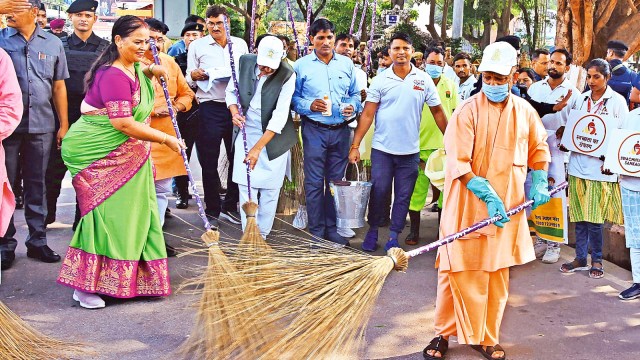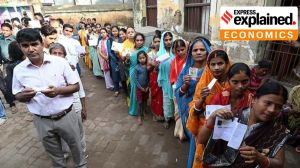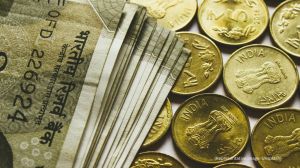UP to be country’s first ‘zero poverty’ state in a year: CM Yogi Adityanath
The zero poverty campaign is aimed at identifying the poorest families from each gram panchayat and to integrate them into the mainstream.
 CM Yogi Adityanath during a cleanliness drive on Gandhi Jayanti, in Lucknow on Wednesday. (Vishal Srivastav)
CM Yogi Adityanath during a cleanliness drive on Gandhi Jayanti, in Lucknow on Wednesday. (Vishal Srivastav)CHIEF MINISTER Yogi Adityanath on Tuesday said that his government would make Uttar Pradesh the country’s first “zero poverty” state within a year.
The zero poverty campaign is aimed at identifying the poorest families from each gram panchayat and to integrate them into the mainstream.
Under the campaign, these families will be given support to be provided food, clothing, quality education, healthcare, housing facilities and a stable source of income.
Chief Secretary Manoj Kumar Singh has issued a detailed action plan to all district magistrates regarding this initiative.
The BJP government claims that UP is set to be the first state in the country to implement such a programme.
According to the action plan, information will be gathered about the poorest 10-25 families in each gram panchayat. A three-tier, hybrid method will be applied for the selection of these families, ensuring a transparent process. The employees, officers, and officials of the gram panchayats involved in each stage of selection will be held accountable.
At the first level, the poorest families will be identified using the ‘Mop-up’ mobile app on the basis of four key criteria: first, families that are homeless or live in kutcha houses; second, landless families reliant solely on agriculture for their livelihoods; third, families dependent on daily wages or agricultural labour, facing uncertain and irregular incomes; and fourth, families lacking financial resources, constantly struggling with food and clothing shortages. Village-level employees and cadres will identify these families, entering their information into the Mop-up mobile app. These employees include Panchayat Assistants (Panchayat Sahayak), Gram Rozgar Sevaks, Samuh Sakhis associated with the Livelihood Mission, and other community cadres, including BC Sakhis.
Families have to be identified on the Mop-up mobile app by village-level employees/cadres through field visits and in the presence of the head of the family. Efforts will be made to ensure that no eligible family is overlooked and that no family is incorrectly categorised based on the established criteria. Each cadre will maintain detailed registrations on the Zero Poverty Portal, allowing for precise mapping of the families they identify, thereby ensuring accountability in cases of inaccurate information.
At the second level, a village-level committee will be established in each gram panchayat, comprising five members: the gram pradhan, the former gram pradhan, the headmaster of the local school, and the head of the two oldest self-help groups. If no self-help groups exist in a gram panchayat, the ASHA worker associated with the Health Department and the Anganwadi Sevika from ICDS will serve as alternate members. A minimum of three out of the five members must agree for a family’s selection.
In the third level, following the identification by the cadre and the recommendations of the village-level committee, families will receive an automated vulnerability rating through a digital system. The standards and framework for this computer-based rating will be accessible via the Mop-up app and the Zero Poverty Campaign platform.
Records for all identified families will undergo scrutiny by the Performance Support Unit, established at the Chief Secretary’s level, which will conduct on-site investigations of any suspicious records. If any discrepancies are found, the expert team will recommend appropriate actions against the responsible cadre and the village-level committee.
The identified poorest families will benefit from various government schemes. This includes support from the Department of Food and Civil Supplies, ensuring that ration cards and rations are provided to those in need. Under rural housing initiatives, families will receive benefits from the Pradhan Mantri Awas Yojana and Mukhyamantri Awas Yojana.
In the education sector, assistance will include school admissions, uniforms, textbooks, and other essential resources. Families will also have access to medical facilities, including benefits from the Ayushman Bharat Insurance Scheme and other Medical and Health Department initiatives. Furthermore, support will be available through schemes from the Labor Department and the BOC Board.
Families will be eligible for benefits from the Integrated Child Development Services Scheme and other programs under MNREGA, the State Rural Livelihood Mission, and the Women, Child Development, and Nutrition Department. Additionally, they will be covered by initiatives from the Jal Jeevan Mission, Namami Gange, and programs focused on rural drinking water and sanitation managed by the Panchayati Raj Department.
They will also be connected to the Skill Development Initiative of the Ministry of Skill Development, Government of India, along with all other schemes related to skill development and employment benefits. At the same time, the benefit of skill development schemes related to Special Central Assistance to SC and ST Sub Plan will also be available.
Moreover, families will be supported by the skill development schemes of the State Skill Development Fund and UP Top Up Fund, as well as the Apprenticeship Training Scheme and other government department initiatives. Additionally, they will benefit from programs run by CSR initiatives and other non-governmental organizations.
The integration of the Zero Poverty portal (Zero Poverty.in) with the Family ID portal will be facilitated through API. For the identified poorest families who are not beneficiaries of the National Food Security Mission or who have not yet received a Family ID, efforts will be made to provide them with ration cards by gathering all necessary family details. In addition, these families will also be eligible for the allocation of a family ID.
To create a tailored plan for sustainable income for the selected poorest families, students from reputable educational institutions in the respective districts will be engaged with these families. After discussions with the identified families, considering the local conditions and available livelihood opportunities, a project will be developed to explore specific economic possibilities. This project will be implemented for the identified poorest families with the collaboration of various departments.







